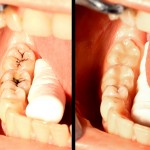
Direct or indirectly placed resin composite materials are increasingly used for the restoration of posterior teeth as aesthetic demands of patients grow and dentistry moves to reduce it use of amalgam. With more than 50% of operative dentistry workload being related to placing and replacing restoration correct use and selection of dental materials is an important element of a restorations success or failure.
The aim of this review was to evaluate the long-term performance of direct versus indirect composite inlays/ onlays in posterior teeth.
Methods
Searches were conducted in the Medline, Embase, Cochrane Oral Health Group’s Trials Register, CENTRAL, ClinicalTrials.gov, the National Research Register, and Pro-Quest Dissertation Abstracts and Thesis databases. There were no language restrictions. Randomised controlled trials (RCTs) in patients of any age receiving direct or indirect composite inlays/onlays with at least 3 years follow up were considered.
Two reviewers independently selected studies, abstracted data and assessed study quality using the Cochrane risk of bias tool. Continuous outcomes were summarised using mean differences, dichotomous data using risk ratios (RR).
Results
- 3 RCTs involving 239 patients (424 restorations) were included
- 2 RCTs involved direct versus indirect inlays, one direct versus indirect onlays.
- 2 studies were considered to be at unclear risk of bias, 1 at high risk.
- Meta-analysis (2 RCTs) showed no statistically significant difference in the risk failure between direct and indirect inlays:-
- At 5 yrs. RR= 1.54. (95%Cl; 0.42 to 5.58; p=0.52)
- At 11yrs. RR= 0.95. (95%CI; 0.34 to 2.63; p=0.92).
- Only one parameter, the marginal discoloration, slightly favoured direct inlays after 11 years (RR:= 0.41; 95% Cl; 0.17, 0.96; p=0.04).
- Only one study dealt with onlays reporting an overall 5-year survival of 87% (95% CI; 81-93%).
Conclusions
The authors concluded: –
Overall, there is insufficient evidence to make strict recommendations in favour of direct over indirect technique. The results of our review and meta-analysis derive from studies with unclear and high risk of bias. Certainly, further well-designed long-term studies should be undertaken in order to make more meaningful comparisons or recommendations about both techniques.
Comments
The authors have conducted a broad search strategy and restricted their review to randomised controlled trial with a duration of 3 years or greater. Only 3 studies met these criteria and the risk of bias in these studies was either unclear of high. This in addition to the fact that only a small number of patients were involved means there is insufficient evidence to inform recommendations for current practice. All 3 studies were also undertaken in a university setting with highly selective patient groups which are likely to have better outcomes that in a general practice environment. A broader review by Morimoto et al (Dental Elf – 24th Jun 2016) reported high survival rates for a range of aesthetic restorative materials although much of the data is that review was obtained from retrospective studies, which are more likely to suffer from bias. As the review authors’ note further well-designed and well-reported studies are needed to better inform clinical practice.
Links
Primary paper
Angeletaki F, Gkogkos A, Papazoglou E, Kloukos D. Direct versus indirect inlay/onlay composite restorations in posterior teeth. A systematic review and meta-analysis. J Dent. 2016 Jul 22. pii: S0300-5712(16)30138-5. doi: 10.1016/j.jdent.2016.07.011. [Epub ahead of print] Review. PubMed PMID: 27452342.
Other references
Dental Elf – 24th Jun 2016

Composite restorations: direct or indirect placement? https://t.co/npd6nJCyeA
[…] post Composite restorations: direct or indirect placement? appeared first […]
Composite restorations: use direct or indirect placement? https://t.co/npd6nJCyeA
No difference in failure rates in direct or indirect composite restorations https://t.co/npd6nJCyeA
Using direct or indirect placement of composite restorations- evidence limited https://t.co/npd6nJCyeA
Direct or indirect composite restorations have similar failure rates https://t.co/npd6nJCyeA
Don’t miss- Composite restorations: direct or indirect placement? https://t.co/npd6nJCyeA
[…] Composite restorations: direct or indirect placement? […]